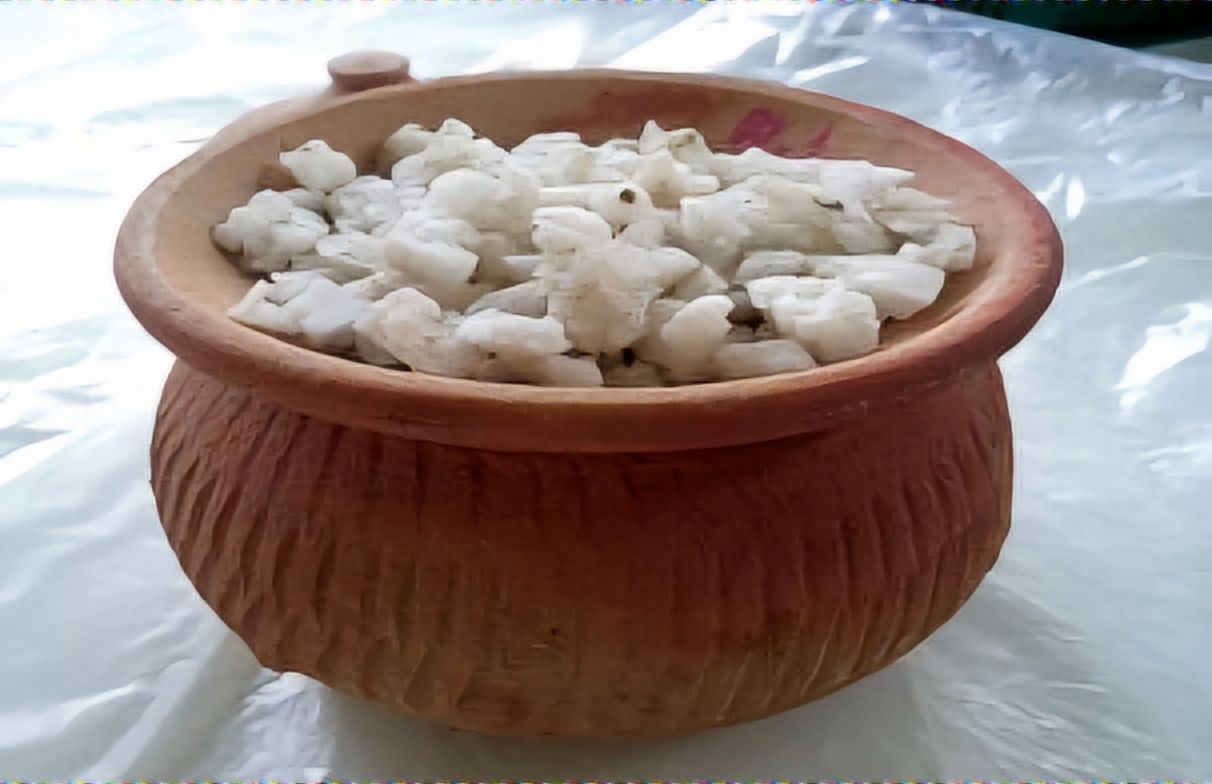Heat Retention Properties of Male and Female Salt in Thai Traditional Medicine
Main Article Content
Abstract
The salt pot compress method in postpartum women involves putting male salt in a clay pot, known as a cooking pot, for heat retention. According to Thai traditional medicine textbooks, there are two types for the nature of salt: male and female. Nonetheless, no report has clearly specified why it needs to be only the male salt and whether it has to be one of either sea salt or rock salt. Some textbooks have not even specifically stated that it must be the male salt. Thus, the objectives of this study are as follows: 1) To determine the heat retention properties of both male and female sea salt; 2) To compare the heat retention properties of both male and female sea salt. The results showed that the size and volume of both types of salt decreased after heating. Meanwhile, higher temperature and a longer time in the pot enhanced the salt’s heat. However, the heat retention time of those types of salt decreased with increasing experimental cycles. Moreover, the male sea salt maintained better heat retention properties than the female sea salt. Thai traditional medicine practitioners suggest the use of male sea salt in the intervention of salt pot compress method. In case male sea salt is not found, large grains of salt will work in its place. Additionally, the heated salt can be reused due to no loss in its heat retention properties for up to 2-3 uses. Nevertheless, increasing the time and energy is required to heat the salt, depending on the number of cycles.
Article Details

This work is licensed under a Creative Commons Attribution-NonCommercial-NoDerivatives 4.0 International License.
References
Office of Academic Affairs, Department of Thai Traditional and Alternative Medicine, Ministry of Public Health. Thai public health report in Thai traditional medicine, folk medicine and alternative medicine 1. Bangkok: The Veterans Welfare Organization's printing house activities office, 2010. pp. 451.
Saowaros, C. Carrying on Thai wisdom for the new generation: Integrating Thai wisdom in caring for maternal health after giving birth. Journal of the Center for Clinical Medicine Education Phrapokklao Hospital, 2019, 36(3), 251-257.
Bunyopasadham, H. Synthesis of research on local wisdom regarding women's health care. Srinakharinwirot Research and Development Journal, 2019, 11(21), 161-73.
Department of Thai Traditional and Alternative Medicine. Guidelines for providing integrated Thai traditional medicine services in primary health care units. Bangkok: Ministry of Public Health, 2019. pp.11.
World Health Organization (WHO).Recommendations on intrapartum care for a positive childbirth experience. Geneva: World Health Organization, 2018.
Chompoonut, S.; Inkaew, W. Integration of academic services with teaching and learning of selected nursing practice subjects in the field of community health nursing. Police Nursing Journal, 2017, 9(1), 24-36.
Kaewsarn, P.; Moyle, W.; Creedy, D. Traditional postpartum practices among Thai women. J Adv Nurs, 2003, 41(4), 358-66. https://doi.org/10.1046/j.1365-2648.2003.02534.x
Taoprasert, Y. Rajabhat Science Community Network Local wisdom in Chiang Rai. Folk Medicine Research and Development Center Chiang Rai Rajabhat Institute. 2003.
Pumtong, S.; Wirasathien, L.; Sitthithaworn, W.; Rungmekarat, A.; Paeratakul, O. Postpartum care through traditional Thai medicine in Amnat Charoen province. Journal of Health Systems Research, 2010, 4(2), 81-95.
Jamjan, L.; Khantarakwong, S.; Hongthong, S.; Jampates, N. Thai traditional medicine for postnatal motherin the community of Central region. Journal of The Royal Thai Army Nurses, 2014, 15(2), 195-202.
Pumtong, S.; Wirasathien, L.; Sitthithaworn, W.; Rungmekarat, A.; Paeratakul, O. Postpartum care through traditional Thai medicine in Amnat Charoen province. Journal of Health Systems Research, 2010, 4(2), 281-95.
Namanee, A. The enhancement of the mother and children’s health care: the perspectives from the Thai medication and the modern medication. Thammasat Medical Journal, 2013, 13(1), 79-88.
Laokhomprutthachan, J.; Laokhomprutthachan, T.;, Kanchanasit, W.; Wongwai, N.; Local wisdom for health: integrated into learning management In caring for mothers after giving birth. Regional Health Promotion Center 9 Journal, 2023, 17(2), 618-630.
Navadach, N.; Inman, W.; Singkhamphong, N.; Boonrasri, S.; Noipha, K. Postnatal mothers’ satisfaction toward post¬partum care project using Thai traditional medicine of Ranod Hospital. Songkhla province. RMUTSV Research Journal, 2020, 12(3), 483-94.
Talib, KA.; Khalid, Mohamed, N. Midwives and herbal remedies: The sustainable ethoscience. Kajian Malaysia, 2020, 38(1), 109-131. https://doi.org/10.21315/km2020.38.s1.7
Ward EA, Iron Cloud-Two Dogs E, Gier EE, Littlefield L, Tandon SD. Cultural adaptation ofthe mothers and babies intervention for use in Tribal communities. Front Psychiatry, 2022, 17(13), 807432. https://doi.org/10.3389/fpsyt.2022.807432
Srithupthai, K.; Moonlao, S.; Satue, K. Effect of salt over pot (tub mor gleur) on reducing hip and waist circumference and body weight in postpartum women. Isan Journal of Pharmaceutical Sciences, 2015, 11(Suppl 1), 203-205.
Ngamrungroj. T.; Wasandilok, A. Study of flow through the surface of dimples and ridges. Numbers. Bachelor of Engineering Thesis Department of Mechanical Engineering Department of Mechanical Engineering Faculty of Cast Engineering Naresuan University. 2006.
Suwannapruek, R. General chemistry volume 1.3. Bangkok: Wittayapat, 2016. pp. 584.
Chuaybamrung, J. Pascal's principle (Pascal'principle) fluid mechanics (Fluid mechanic) General physics 1, mechanics section, for industrial technology students. Faculty of Industrial Science and Technology Prince of Songkla University Surat Thani Campus. 2008, pp. 214-215.


